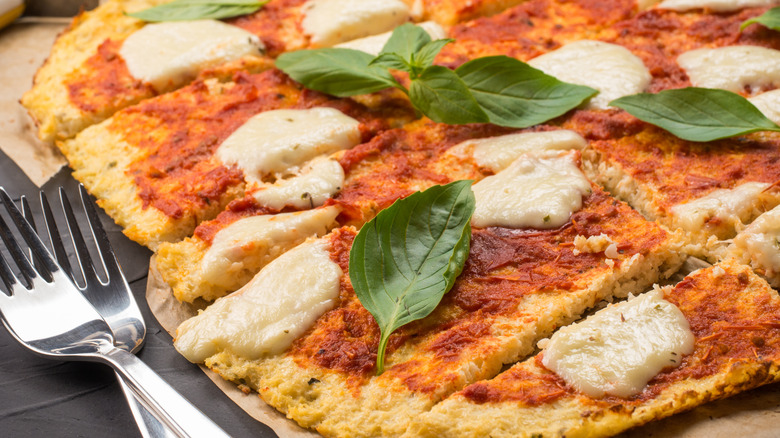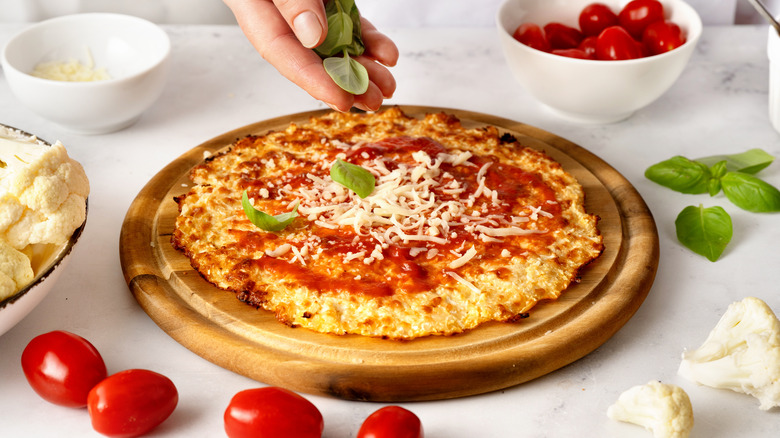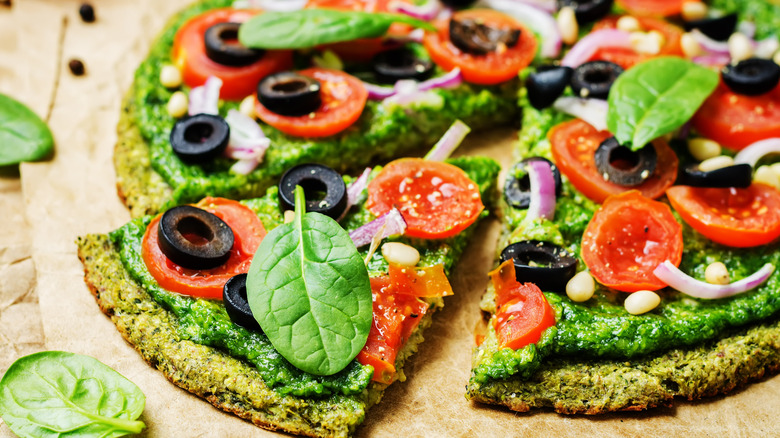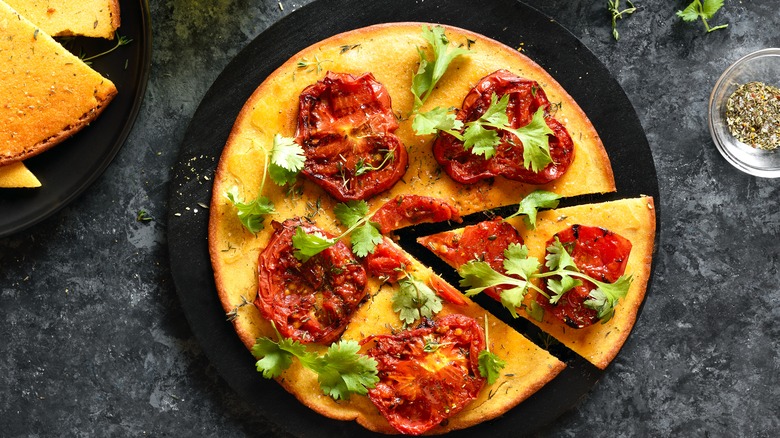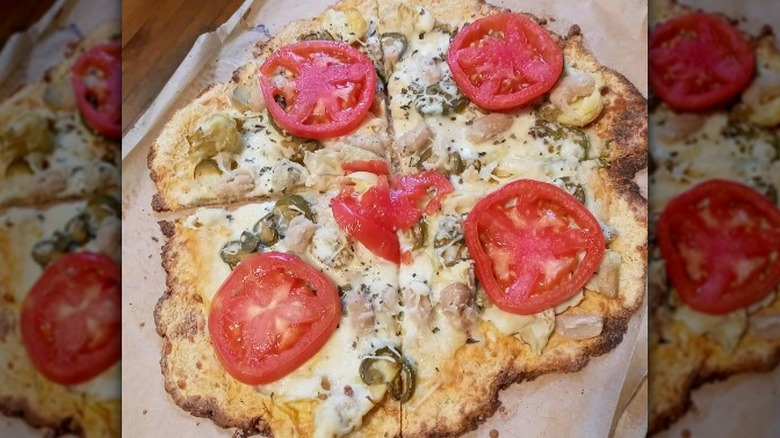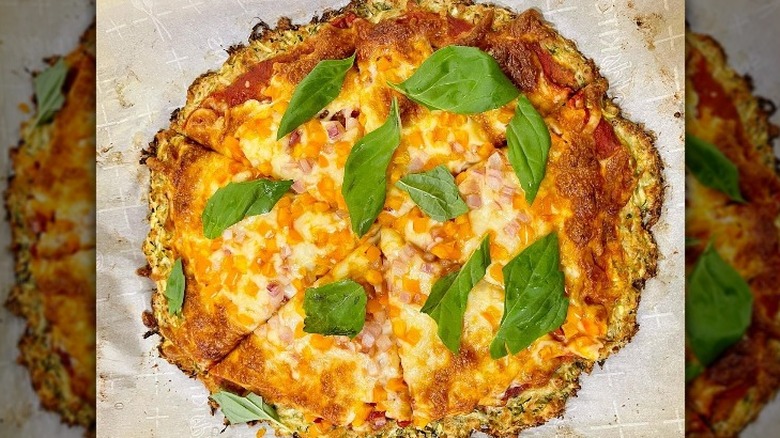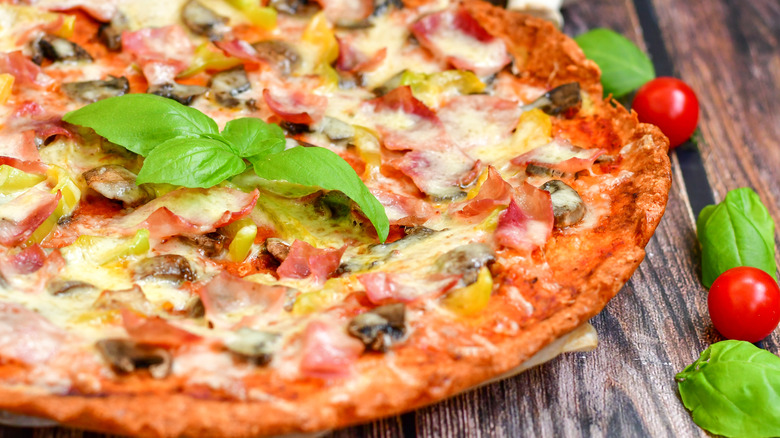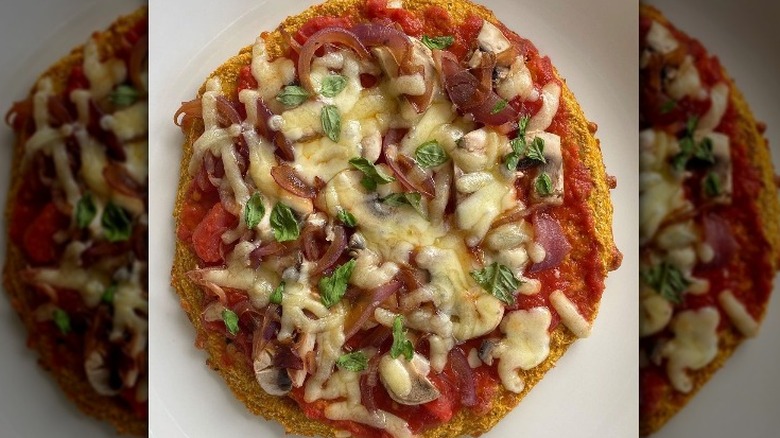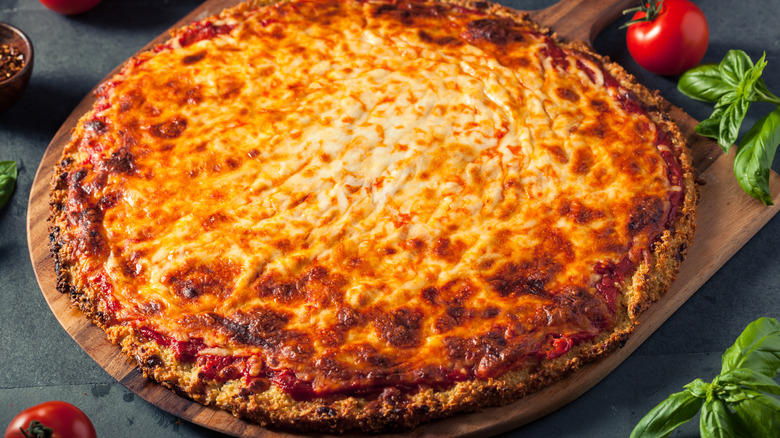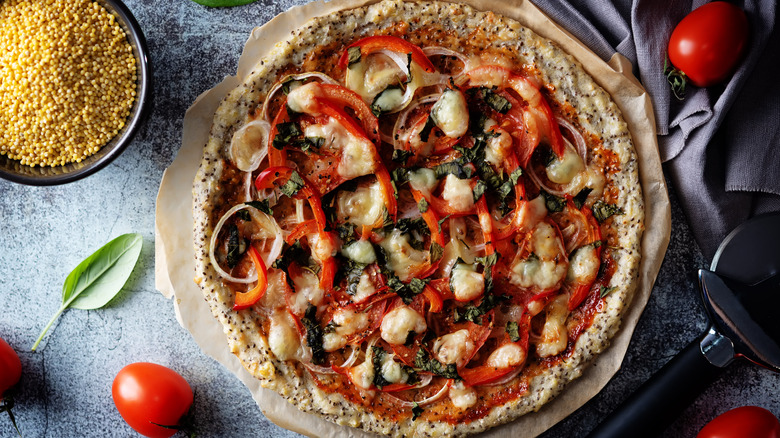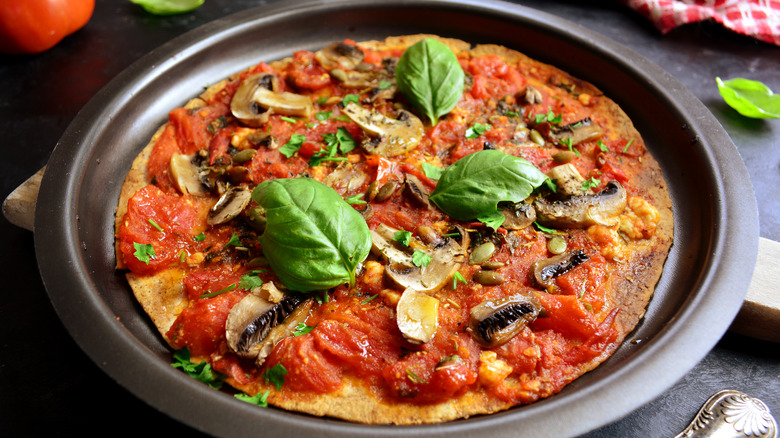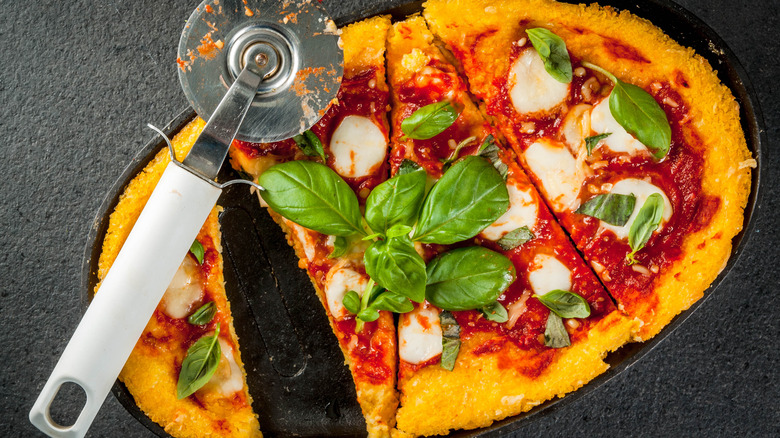11 Gluten Free Pizza Crust Alternatives
It's hard to find someone who doesn't love pizza, but for a number of people, pizza doesn't like them. Gluten allergies and intolerances can wreak havoc on your dining habits, but thankfully, there are plenty of alternatives that do a commendable job. There's a whole market of gluten-free flours, but in our selection of pizza crusts, we're focusing on ingredients that stand on their own.
While the effect isn't going to be the same as biting into a doughy slice of pizza, our recommendations have their own thing going on. From cheesy crusts to nutty flavors, not to mention those loaded up with vegetables and others with gluten-free grains, we're sure you'll find a new favorite. Keep in mind that if you have allergies to dairy, eggs, or nuts, these ingredients are often present in gluten-free crusts. Of course, if you're making it yourself, then you'll be able to include exactly what suits you.
Cauliflower
Cauliflower pizza crusts have certainly gained a reputation among people looking for gluten or a flour-free option to replace the standard wheat base. Chalk it up to the popularity of Trader Joe's latest gluten-free pizza crust, or perhaps simply the fact that cauliflower has taken on a superhero role as the cruciferous vegetable that can do it all. Regardless, a well-made cauliflower crust will have naysayers reaching for another slice.
The keto version of this lovable recipe includes eggs and plenty of cheese. However, if you're happy to keep the cheese as a topping and want your crust to offer other qualities, renditions made with coconut or almond flour, flax meal, or simply eggs as a binder are just as delicious.
Pro tip: Unless you have a lot of patience, you're best off buying riced cauliflower to speed up the process. Lightly steam the cauliflower and drain away excess water; then, it's just a matter of combining the ingredients into a puree that you can shape onto a baking sheet. To avoid a soggy pizza, be sure to bake the crust first and then use a light hand with the toppings.
Meanwhile, if you'd rather skip the part where you actually make the crust, Caulipower has been winning hearts across the country. Aside from cauliflower, the ingredient list includes rice flour, corn starch, tapioca starch, and eggs to create a perfectly chewy crust.
Broccoli
We're not sure why broccoli doesn't get to play dress-up as much as its cruciferous sibling, but we're hoping it gets its time in the spotlight too. As it turns out, this green vegetable does an admirable job of becoming a pizza crust. If you've mastered the cauliflower technique, you'll be glad to know there's a lot of overlap.
Broccoli needs to be riced, steamed, strained, and then processed into a mash with binders like eggs and cheese. Similarly, if you want to limit the dairy content, then use another option to combine the ingredients, such as chickpea flour or ground oats, along with eggs. It's hard not to feel good about pizza night when the foundation is packed with vitamins and minerals.
For busy evenings or when you want to host a gluten-free pizza night without spending all day ricing and steaming broccoli, Outer Aisle makes delicious crusts that double as wraps. There's no need to worry about endless ingredients either, as the product is made with four simple elements: broccoli, Parmesan, eggs, and nutritional yeast.
Chickpea flour
The humble chickpea has long been put in a box as the basis of hummus, but it has lots more going for it. Both the mashed legume and flour made from dried chickpeas can be the foundation for your next gluten-free pizza crust. The latter actually has a long history used to make flatbread in certain coastal regions of Europe. Socca is a popular French street food commonly found in the southern region of the country. On Italy's Ligurian coast, farinata flatbread is a similar dish.
Making a socca pizza recipe is incredibly easy and mainly requires chickpea flour, olive oil, water, and seasonings. You'll need to whisk everything together into a smooth batter and let it sit while it thickens. After that, it's just a matter of broiling it or cooking it in a flat pan. Add your toppings and bake if required — or keep the top light and fresh with salad-like garnishes and let the nuttiness of the flour stand out.
Buy a bag of chickpea flour and whip this up in no time, or pick up premade crusts by Banza. The company uses chickpeas, tapioca, cocoa butter, olive oil, and seasonings, which makes it a great gluten and dairy-free option to pick up on your next shopping trip.
Spaghetti squash
This stringy squash does a great job pretending to be pasta, and it's a surprisingly creative way to make pizza crust too. Before you start mixing and binding ingredients, you'll need to cook the squash to reveal its spaghetti-like strands. There are a number of ways to prepare it, such as microwaving, boiling, or roasting. For maximum flavor and minimal moisture, roasting it in the oven is a safe bet.
To speed up the process, the two best methods for cutting spaghetti squash are lengthwise or in rings. After you remove all the flesh, you'll still want to drain off excess water, or you'll be left with a very soggy result that won't really pass as pizza crust. Then, it's a matter of mixing the squash with binders like eggs, cheese, or a small amount of your favorite gluten-free flour. Flatten the mixture out into a circle (or whatever shape you're inspired by) and bake the crust until it's golden and holds together. At this point, add whatever toppings you're in the mood for and bake it to completion.
Zucchini
You might be catching on to the fact that vegetables used as gluten-free pasta alternatives often double up as pizza crust. Zucchini is no exception, and as with the others mentioned on our list, the key factor to success is straining off the excess water. We guarantee that if you forget this step, you'll steer clear of these alternatives for fear of another liquidy disappointment.
There are a few different techniques and various binders that you can use to perfect your zucchini crust, so you'll want to experiment and find your favorite. All begin by grating the zucchini, some follow up by baking the shredded vegetable first, while others keep it raw. Strain the excess moisture and combine it with other ingredients like shredded cheese, almond flour, eggs, or ground flaxseed, depending on whether or not you're aiming for a vegan and gluten-free crust. Bake the base, top it modestly with garnishes (too many will cause it to become soggy), and dig in.
While grating zucchini is less arduous than ricing cauliflower, if you want an easy and tasty shortcut, Kbosh produces gluten-free keto-friendly zucchini crusts loaded with cheese, eggs, almond flour, coconut flour, and flaxseed meal. Nutritious and free of preservatives or added sugars, these packaged pizza crusts are a meal prepper's dream.
Almond flour
Almond flour (more so than almond meal, which is coarser) is an excellent gluten-free option for pizza crusts. If you've experimented with wheat flour alternatives, chances are you've come across it, although the two can't always be used interchangeably. You'll be glad to know almond flour works fine to make pizza crust.
Keto pizza recipes often use almond flour along with eggs and shredded cheese to create a batter — sound familiar? Again, if tons of cheese isn't your thing, just whisking the flour with an egg, baking soda, and seasonings works too. Be sure to combine the ingredients well to eliminate lumps; a food processor can help achieve a smooth result. Unless you melt the cheese before adding it, you'll need to pre-bake the crust before loading the toppings.
Cappello's is the obvious option for a packaged version that will taste just as good. The company makes two almond flour options: the naked pizza crust with eggs, cheese, and various gluten-free flours and a keto pizza crust with turnip, eggs, cheese, and a few other binders. You can even buy the pizzas already dressed with cheese, sausage, vegetables, and assorted toppings.
Pumpkin puree
It's hard not to be inspired by the influx of squash and pumpkin seasonally. Pumpkin pie and jack-o-lanterns are timeless classics, but the next time you pick up a pumpkin, we challenge you to make pizza crust. Wedges of roasted pumpkin or opting for puree instead of tomato sauce are great toppings, but using it to make the crust is a lesser-known winner. Aside from being so nutritious, pumpkin adds a sweet and earthy flavor to the pizza that pairs well with toppings like goat cheese, caramelized onions, and fresh herbs (try pesto!).
Either cook and mash it yourself or use canned pumpkin; just avoid pumpkin pie filling — you'll taste the difference. Naturally, pumpkin puree is quite creamy and not starchy enough to stand on its own as a pizza crust. Your favorite gluten-free flour (buckwheat, amaranth, tapioca, almond, arrowroot, etc.), eggs, olive oil, and seasoning make a batter with a suitable consistency, and vegan variations are successful too. Pre-bake it first, then add fresh vegetables from the fall harvest to top it off.
Quinoa
Regularly touted as an impressive superfood, quinoa even functions as the primary ingredient in gluten-free pizza crust. Unlike wheat flour, quinoa (and the flour made from it) contain notable levels of protein, fiber, vitamins, minerals, and antioxidants (via Healthline). Quinoa's pleasantly nutty flavor makes it a unique option, and the texture varies depending on whether the quinoa is raw, cooked, or used in its flour form.
Recipes that opt for raw quinoa typically soak it before blending the seeds with water and cheese. Meanwhile, cooked quinoa mixed with cheese and eggs has more of a textural element. You'll need to prebake the crust as the batter is fairly wet; however, once it's cooked, it holds up well to toppings.
If you want a process similar to making wheat flour dough, pick up a bag of quinoa flour. For the ideal texture, you'll still need to mix it with additional starches; psyllium husk and tapioca starch are good gluten-free options.
Seeds
We've touched upon using ground flaxseeds in pizza crusts as a binder or vegan egg replacement, but plenty of other seeds can play a role. Since seeds can behave quite differently (as you'll realize when you add water to chia seeds), you're best off following a recipe unless you enjoy experimenting in the kitchen. Flax, chia, sesame, pumpkin, sunflower, and hemp hearts are all great options.
Depending on the texture you're aiming for, you might want to keep some of the seeds whole. Eggs, olive oil, and small amounts of gluten-free flour can help you achieve the desired texture. You'll want to pre-bake the crust for optimal results or if you're savvy with a dehydrator, consider using it to prepare your seed crust.
Lizza makes tasty rectangular pizza crusts from ground golden flax seeds, though the product also contains soy flour which might be a dealbreaker for some people. Meanwhile, if you're looking to make individual mini pizzas, Mauk Family Farms sells raw vegan crusts made from sprouted sesame seeds, sunflower seeds, and flaxseeds.
Tortillas
Traditional corn tortillas are made by grinding kernels. However, cornmeal or corn flour are common swaps (via Healthline). Naturally, they shouldn't contain gluten, but some recipes and packaged products add wheat flour to modify the consistency. Be sure to examine labels to ensure that any tortillas you buy in the supermarket are genuinely gluten-free.
If you're making your own, many classic corn tortilla recipes use a simpler method than hand-grinding kernels, and corn flour is often used in place. Instead of baking the dough, heat a skillet and cook the crusts on the stovetop first. Once you add toppings, you can bake the pizza to cook the remaining ingredients. Keep in mind that with most tortillas, the final result will be more similar to a cracker than a doughy pizza, but sometimes that's exactly what you want.
If you feel like expanding your palate, there are dozens of gluten-free tortilla products on the market that require zero prep time. Real Coconut Market offers an option made primarily with coconut flour and cassava starch. Get inspired to whip up a tropical pizza (or wrap) with these vegan and gluten-free crusts. Meanwhile, La Tortilla Factory produces a few suitable options made with cooking ingredients like teff, cassava flour, and even cauliflower.
Polenta
It's worth thinking of other popular Italian starches when whipping up a gluten-free pizza crust. Polenta tastes like soft, grainy goodness, as it is basically ground cornmeal, and depending on the type you buy, it's either an instant cooking process or a tedious one that requires non-stop stirring. A creamy consistency is often the goal, but with regard to pizza crust, it's best if it firms up a bit. This can be achieved by chilling it in the refrigerator after spreading it out on a sheet pan and baking it before adding on your favorite toppings for the second bake.
You'll probably need to use a fork and a knife to devour this tasty pizza because a polenta crust might not be sturdy enough to stand up to the weight of your garnishes. No matter the extra cutlery, the contrast between the crispy bottom, creamy center, and flavor-packed toppings is a definite winner. Polenta works well with ragouts, tomato sauce, and cheese, so let its subtly sweet corn flavor inspire your next pizza night.
